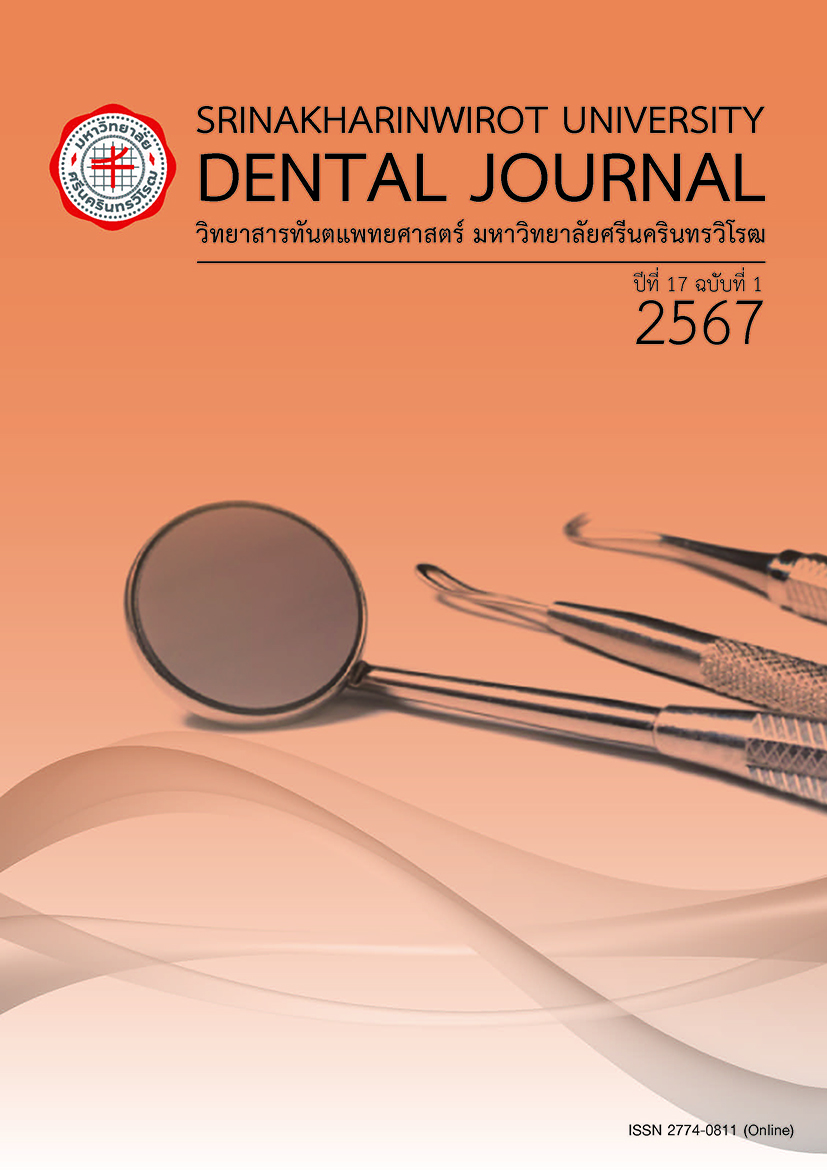อิทธิพลของระยะเวลาทำงานที่หลากหลายต่อคุณสมบัติเชิงกายภาพของเรซินโมดิฟายด์กลาสไอโอโนเมอร์ซีเมนต์ 3 ชนิด
Influence of Working Time Variations on Physical Properties of Three Resin-modified Glass Ionomer Cements.
Keywords:
เรซินโมดิฟายด์กลาสไอโอโนเมอร์ซีเมนต์, การดูดซับน้ำ, การละลายตัว, การถูกกัดกร่อน, การฉายแสง, ระยะเวลาทำงาน, Resin-modified glass ionomer cement, Water sorption, Water solubility, Acid erosion, Light activation, Working timeAbstract
วัตถุประสงค์: เพื่อเปรียบเทียบผลของระยะเวลาทำงานที่แตกต่างกันต่อการดูดซับน้ำ การละลายตัวในน้ำและการถูกกัดกร่อนโดยกรดของวัสดุเรซินโมดิฟายด์กลาสไอโอโนเมอร์ซีเมนต์ วัสดุอุปกรณ์และวิธีการ: นำวัสดุเรซินโมดิฟายด์กลาสไอโอโนเมอร์ซีเมนต์ 3 ผลิตภัณฑ์ ได้แก่ Fuji II LCTM Capsule (GC Corporation; Tokyo, Japan), Riva Light Cure (SDI; Bayswater, Australia) และ Riva Light Cure HV (SDI; Bayswater, Australia) มาศึกษาผลของระยะเวลาที่ชะลอการฉายแสงต่อการดูดซับน้ำ การละลายตัวในน้ำ และการถูกกัดกร่อนโดยกรด โดยทดสอบตามมาตรฐาน ISO 4049:2000 (E) และ ISO 9917-1:2007 (E) วัสดุแต่ละผลิตภัณฑ์ถูกแบ่งออกเป็น 4 กลุ่มตามระยะเวลาที่รอก่อนการฉายแสง ได้แก่ 1 นาที, 10 นาที, 15 นาที และกลุ่มควบคุม ซึ่งเป็นระยะเวลาทำงานที่บริษัทผู้ผลิตกำหนดการดูดซับน้ำและการละลายตัวในน้ำทดสอบโดยการนำตัวอย่างทดลองขนาดเส้นผ่านศูนย์กลาง 15 มม. หนา 1 มม. ไปทำให้แห้งด้วยสารดูดความชื้น ทำการบันทึกปริมาตรและน้ำหนักก่อนแช่น้ำ จากนั้นจึงแช่น้ำเป็นเวลา 7 วัน แล้วบันทึกค่าน้ำหนักที่เพิ่มขึ้นต่อปริมาตรเป็นค่าการดูดซับน้ำ นำตัวอย่างทดลองไปทำให้แห้งอีกครั้งด้วยสารดูดความชื้น บันทึกน้ำหนักที่หายไปเทียบกับน้ำหนักต่อปริมาตรก่อนการแช่น้ำเป็นค่าการละลายตัวในน้ำ ส่วนการถูกกัดกร่อนโดยกรดจะใช้ตัวอย่างทดลองขนาดเส้นผ่านศูนย์กลาง 5 มม. หนา 2 มม. ที่ก่อตัวอยู่ในแบบหล่ออะคริลิก นำไปแช่ในสารละลายกรดแลคติกความเข้มข้น 0.1 โมล/ลิตร เป็นเวลา 24 ชั่วโมง วัดระดับผิวหน้าของวัสดุที่เปลี่ยนแปลงไปหลังจากการแช่กรดเป็นค่าการถูกกัดกร่อนโดยกรด ผลการศึกษา: การเพิ่มระยะเวลาทำงานส่งผลให้การดูดซับน้ำของ Fuji II LC Capsule และ Riva Light Cure HV มีค่าลดลง แต่ไม่มีผลต่อการดูดซับน้ำของ Riva Light Cure การละลายตัวในน้ำและการถูกกัดกร่อนโดยกรดไม่ได้รับผลกระทบจากการเพิ่มระยะเวลาทำงานในทุกผลิตภัณฑ์ สรุป: การเพิ่มระยะเวลาทำงานส่งผลให้เกิดการดูดซับน้ำลดลงใน Fuji II LC Capsule และ Riva Light Cure HV แต่ไม่ส่งผลต่อการละลายตัวในน้ำ และการถูกกัดกร่อนโดยกรดของวัสดุเรซินโมดิฟายด์กลาส ไอโอโนเมอร์ซีเมนต์ทุกผลิตภัณฑ์ที่นำมาทดสอบ Objective: To evaluate the influence of working time variations on water sorption, water solubility and acid erosion of resin-modified glass ionomer cements. Materials and Methods: Three resin-modified glass ionomer cements, including Fuji II LCTM Capsule (GC Corporation; Tokyo, Japan), Riva Light Cure (SDI; Bayswater, Australia) and Riva Light Cure HV (SDI; Bayswater, Australia), were used to evaluate water sorption, water solubility and acid erosion by following the instructions of ISO 4049:2000 (E) and ISO 9917-1:2007 (E). Each product consisted of four experimental groups subjected to different light activation starting time after mixing. There were 1-minute, 10-minute, 15-minute and control. The control group was the working time recommended by manufacturers. For water sorption and water solubility tests, specimens with diameter of 15 mm and thickness of 1 mm were dried with desiccant. The weight and volume were recorded before water storage. Specimens were stored in water for seven days and weighed again. The increasing weight per volume after water storage was defined as water sorption value. The specimens were then dried with desiccant and weighed again. The reducing weight compared with the weight per volume before water storage was defined as water solubility value. For the acid erosion test, specimens with diameter of 5 mm and thickness of 2 mm in acrylic molds were immersed in 0.1 mol/l lactic acid solution for 24 hours. The eroded surface of specimen compared with the surface of the acrylic mold was recorded as acid erosion value. Results: Increased working time decreased water sorption in Fuji II LCTM Capsule and Riva Light Cure HV but not in Riva Light Cure. However, increased working time had no influence on water solubility and acid erosion of all products. Conclusion: Increased working time decreased water sorption in Fuji II LCTM Capsule Riva Light Cure HV but had no influence on water solubility and acid erosion of resin-modified glass ionomer cements used in this study.Downloads
References
Mathis RS, Ferracane JL. Properties of a glass-ionomer/resin-composite hybrid material. Dent Mater. 1989;5(5):355-8.
Rizzante F, Cunali R, Bombonatti J, Correr G, Gonzaga C, Furuse A. Indications and restorative techniques for glass ionomer cement. RSBO. 2015;12(1):79-87.2016;12:79.
Wilson AD, Nicholson JW. Acid-Base Cements: Their biomedical and industrial applications: Cambridge University Press; 2005.
Berzins DW, Abey S, Costache MC, Wilkie CA, Roberts HW. Resin-modified glassionomer setting reaction competition. J Dent Res. 2010;89(1):82-6.
Butda P, Prasansuttiporn T, Thanatvarakorn O, Jittidecharaks S. Effect of waiting interval before light curing on bond strength of resin modified glass ionomer cement under simulated pulp pressure. CM Dent J. 2018;39(1):113-25.
Dursun E, Nguyen JF, Tang ML, Attal JP, Sadoun M. HEMA release and degree of conversion from a resin-modified glass ionomer cement after various delays of light activation. Dent Mater. 2016;32(5):640-5.
Lagarde M, Francois P, Goff SL, Attal JP, Dursun E. Structural and long-term mechanical properties from a resin-modified glass ionomer cement after various delays of light-activation. Dent Mater J. 2018;37(6):874-9.
Sokolowski K, Szczesio-Wlodarczyk A, Bociong K, Krasowski M, Fronczek-Wojciechowska M, Domarecka M, et al. Contraction and Hydroscopic Expansion Stress of Dental Ion-Releasing Polymeric Materials. Polymers (Basel). 2018;10(10):1093. doi: 10.3390/polym10101093.
International Organization for Standardization.International Standard-ISO 4049: Dentistry : Polymer-based Restorative Materials.ISO; 2000.
International Organization for Standardization.International Standard-ISO 9917-1: Dental Water-based Cements - Part 1 : Powder/liquid acid-base cement. 2nd ed: ISO; 2007.
Ferracane JL. Hygroscopic and hydrolytic effects in dental polymer networks. Dent Mater. 2006;22(3):211-22.
Toledano M, Osorio R, Osorio E, Fuentes V, Prati C, Garcia-Godoy F. Sorption and solubility of resin-based restorative dental materials. J Dent. 2003;31(1):43-50.
Nicholson JW. Maturation processes in glass-ionomer dental cements. Acta Biomater Odontol Scand. 2018;4(1):63-71.
GC Fuji IITM LC Capsule’s instruction for use. USA: GC Corporation; 2019.
RIVA Light Cure HV High viscosity light cured resin reinforced glass ionomer restorative material instruction for use. Australia: SDI Limited;2021.
RIVA Light Cure Light cured resin reinforced glass ionomer restorative material instruction for use. Australia: SDI Limited; 2022.
Hazar-Yoruc B, Bavbek AB, Ozcan M. The erosion kinetics of conventional and esin-modified glass-ionomer luting cements in acidic buffer solutions. Dent Mater J. 2012;31(6):1068-74.
Wan Bakar W, McIntyre J. Susceptibility of selected tooth-coloured dental materials to damage by common erosive acids. Aust Dent J. 2008;53(3):226-34.
Jevnikar P, Sersa I, Sepe A, Jarh O, Funduk N. Effect of surface coating on water migration into resin-modified glass ionomer cements: a magnetic resonance micro-imaging study. Magn Reson Med. 2000;44(5):686-91.
Downloads
Published
How to Cite
Issue
Section
License
Copyright (c) 2024 Srinakharinwirot University Dental Journal (E-ISSN 2774-0811)

This work is licensed under a Creative Commons Attribution-NonCommercial-NoDerivatives 4.0 International License.
เจ้าของบทความต้องมอบลิขสิทธิ์ในการตีพิมพ์แก่วิทยาสาร โดยเขียนเป็นลายลักษณ์อักษรแนบมาพร้อมบทความที่ส่งมาตีพิมพ์ ตามแบบฟอร์ม "The cover letter format" รวมทั้งต้องมีลายมือชื่อของผู้เขียนทุกท่านรับรองว่าบทความดังกล่าวส่งมาตีพิมพ์ที่วิทยาสารนี้แห่งเดียวเท่านั้น




